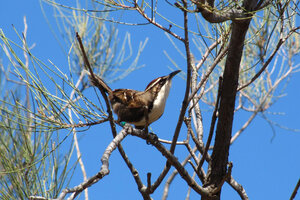What's in a song? Babbler birds structure calls similar to way humans do
Humans aren't the only creatures that string sounds together to convey unique meanings. Research shows chestnut-crowned babbler birds have their own vocabulary.

A chestnut-crowned babbler bird sits on a branch. A new study released Monday deciphered bird sounds to reveal language precursors in the chestnut-crowned babbler birds.
Courtesy of Jodie Crane/University of Exeter
Talking birds have long been relegated to the realm of children’s cartoons, but new research shows that Tweety’s vocal observations of puddy tats may not be as unrealistic as we think.
It was previously thought that humans were the only species that could communicate by stringing together meaningless sounds in order to create meaningful ones. Now, scientists at the Universities of Exeter and Zurich have discovered that a type of bird known as babbler birds do the same thing.
Researchers found that the highly social chestnut-crowned babbler, which hails from the Australian Outback, has the ability to communicate new meaning by rearranging the meaningless sounds in its calls. This is similar to how humans form meaningful words.
"Although previous studies indicate that animals, particularly birds, are capable of stringing different sounds together as part of a complex song, these songs generally lack a specific meaning and changing the arrangement of sounds within a song does not seem to alter its overall message," Sabrina Engesser, one of the researchers, said in a press release.
"In contrast to most songbirds, the chestnut-crowned babblers do not sing,” she explained. “Instead, its extensive vocal repertoire is characterized by discrete calls made up of smaller acoustically distinct individual sounds.”
Ms. Engesser and her colleagues first noticed that the birds reused two sounds, A and B, in different arrangements while engaging in specific behaviors. A flight call produced while flying, AB, had different meaning than a BAB call produced while feeding chicks.
While the birds showed that they could tell the difference between the two arrangements by looking at the nests when they heard a feeding call and by looking out for incoming birds when they heard a flight call, they also could tell the difference when the researchers made flight calls from feeding elements and feeding calls from flight elements. This demonstrated that the two calls were rearrangements of the same sounds.
According to behavioral ecologist and co-author Andy Russell, who has been studying babblers since 2004, the birds may rearrange sounds to code new meaning because “doing so through combining two existing sounds is quicker than evolving a new sound altogether.”
Researchers say their findings, which are published in the journal PLOS Biology, reveal “a potential early step in the emergence of the elaborate language systems we use today.”
Talking birds have long been designated to the realm of children’s cartoons, but new research shows that Tweety’s vocal observations of puddy tats may not be as unrealistic as we think.
It was previously thought that humans were the only species that could communicate by stringing together meaningless sounds in order to create meaningful ones. Now, scientists at the Universities of Exeter and Zurich have discovered that a kind of bird called “babbler birds” do the same thing.
Researchers found that the highly social chestnut-crowned babbler, which hails from the Australian Outback, has the ability to communicate new meaning by rearranging the meaningless sounds in its calls. This is similar to how humans form meaningful words.
"Although previous studies indicate that animals, particularly birds, are capable of stringing different sounds together as part of a complex song, these songs generally lack a specific meaning and changing the arrangement of sounds within a song does not seem to alter its overall message," Sabrina Engesser, one of the researchers, said in a press release.
"In contrast to most songbirds, the chesnut-crowned babblers do not sing,” she explained. “Instead, its extensive vocal repertoire is characterized by discrete calls made up of smaller acoustically distinct individual sounds.”
Engesser and her colleagues first noticed that the birds reused two sounds, A and B, in different arrangements while engaging in specific behaviors. A flight call produced while flying, AB, had different meaning than a BAB call produced while feeding chicks.
While the birds showed that they could tell the difference between the two arrangements by looking at the nests when they heard a feeding call and by looking out for incoming birds when they heard a flight call, they also could tell the difference when the researchers made flight calls from feeding elements and feeding calls from flight elements. This demonstrated that the two calls were rearrangements of the same sounds.
According to co-author Professor Andy Russell, who has been studying babblers since 2004, they believe the birds may rearrange sounds to code new meaning because “doing so through combining two existing sounds is quicker than evolving a new sound altogether.”
Reserachers say their findings, which are published in the open source journal PLOS Biology, reveal “a potential early step in the emergence of the elaborate language systems we use today.”

